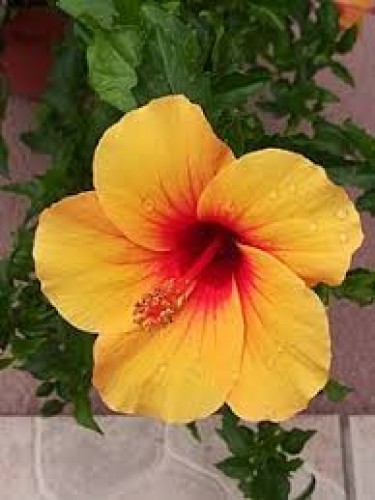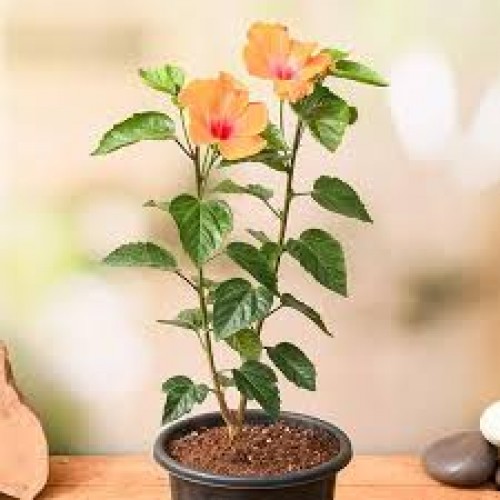off
-
Sold
-

-

out
English Hibiscus Plant: Nature, Care & Advantages
The **English Hibiscus plant** (*Hibiscus rosa-sinensis*), also known as the *Chinese Hibiscus*, is a widely grown ornamental plant, prized for its large, colorful blooms. Though often confused with tropical hibiscus varieties, the English Hibiscus is hardy and commonly cultivated in temperate and subtropical regions. Its vibrant flowers and striking foliage make it an ideal choice for both gardens and indoor spaces.
Nature of the English Hibiscus Plant
The English Hibiscus is a shrub or small tree that can grow between 2 to 4 feet tall. It is known for its striking, funnel-shaped flowers, which can be white, red, pink, orange, yellow, or purple. These flowers are often large (up to 6 inches wide) and bloom in a showy fashion, making them perfect for garden beds or potted plants. The leaves are dark green and glossy, providing a beautiful contrast to the bright blooms. The plant thrives in mild to warm climates, and with the right care, it can bloom throughout the year.
Care for the English Hibiscus Plant
- Climate: The English Hibiscus prefers warm and temperate climates. It thrives in temperatures between 15°C and 30°C. While it can tolerate light frost, it is best grown in regions with mild winters. During the colder months, it can be brought indoors to protect it from freezing temperatures.
- Soil: English Hibiscus plants prefer slightly acidic to neutral, well-drained soil. Use a loamy soil mix that allows for proper drainage and is rich in organic matter. The plant should not be grown in waterlogged soil, as this can lead to root rot.
- Watering: Regular watering is essential, especially during the growing season (spring through summer). Keep the soil moist but not soggy, as excessive moisture can lead to root damage. During the winter months, reduce watering, allowing the soil to dry out slightly between waterings.
- Sunlight: The English Hibiscus plant requires full sunlight to thrive and bloom. Aim for at least 6-8 hours of direct sunlight daily. In regions with intense heat, providing some afternoon shade may help prevent the plant from getting scorched.
- Fertilizing: Fertilize the plant with a balanced, water-soluble fertilizer during the growing season. A monthly feeding schedule is recommended for healthy growth and abundant blooms. Reduce fertilization during the winter months when the plant is dormant.
- Pruning: Regular pruning helps maintain the shape of the plant and encourages better flowering. Remove dead or damaged branches and cut back the plant to promote new growth. Pruning after the flowering season, usually in late fall or early spring, is ideal.
- Propagation: English Hibiscus can be propagated from cuttings. Take a healthy 4-inch stem cutting, remove the lower leaves, and plant it in moist, well-drained soil. The cutting can be rooted in a warm, humid environment and will develop roots in a few weeks.
Advantages of the English Hibiscus Plant
- Ornamental Value: The English Hibiscus is highly valued for its striking flowers, making it an excellent ornamental plant for gardens, patios, and indoor spaces. The plant adds vibrant color to any landscape, particularly in temperate or subtropical climates.
- Low Maintenance: Compared to other flowering shrubs, English Hibiscus is relatively low maintenance. It requires minimal care once established, making it an ideal choice for beginner gardeners or those with limited time for plant care.
- Health Benefits: The flowers and leaves of the hibiscus plant are rich in antioxidants and compounds like anthocyanins and flavonoids, which are believed to help reduce oxidative stress. Hibiscus tea, made from its flowers, is known for its potential benefits in lowering blood pressure and promoting heart health.
- Attracts Pollinators: The bright, colorful flowers of the English Hibiscus attract a variety of pollinators, including bees, butterflies, and hummingbirds, making it a wonderful addition to pollinator-friendly gardens.
- Air Purification: Like many other plants, English Hibiscus helps to improve air quality by absorbing carbon dioxide and releasing oxygen. Its glossy green leaves add to the aesthetic value of your space while contributing to healthier indoor air quality.
- Edible Use: While not as common as other varieties, some cultures use hibiscus flowers in culinary preparations, such as in making herbal teas, jams, and syrups. The flowers have a tangy, slightly sour flavor that complements various recipes.
- Symbolism: The hibiscus is a symbol of beauty, love, and passion in various cultures. In some regions, the plant is associated with the celebration of life and positivity. It is often used in religious and cultural ceremonies.
Conclusion
The **English Hibiscus** plant is an outstanding choice for gardeners and plant enthusiasts who seek an easy-to-care-for, yet visually stunning addition to their space. With its rich, colorful blooms and numerous advantages, including health benefits, pollinator attraction, and low maintenance, this hardy plant is sure to brighten any garden or indoor area. Whether you are growing it for its aesthetic appeal, medicinal properties, or as part of a pollinator-friendly garden, the English Hibiscus is a plant that offers both beauty and practicality.